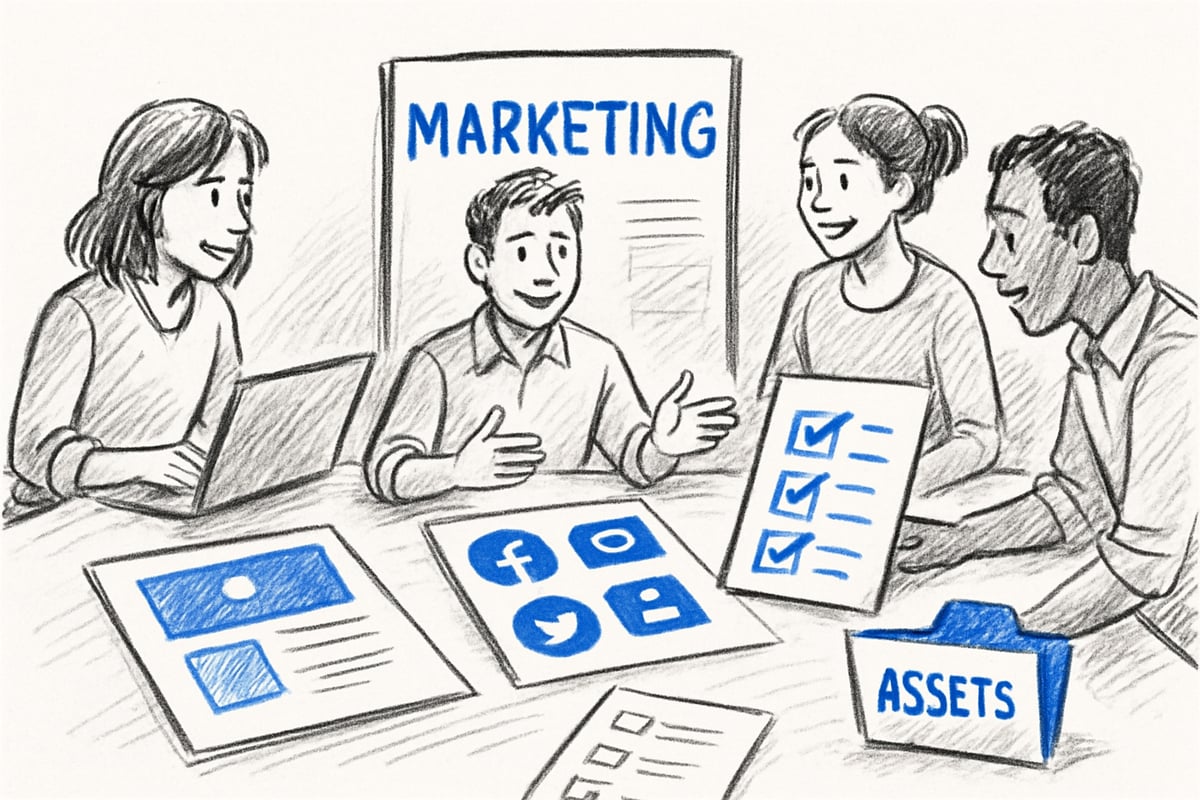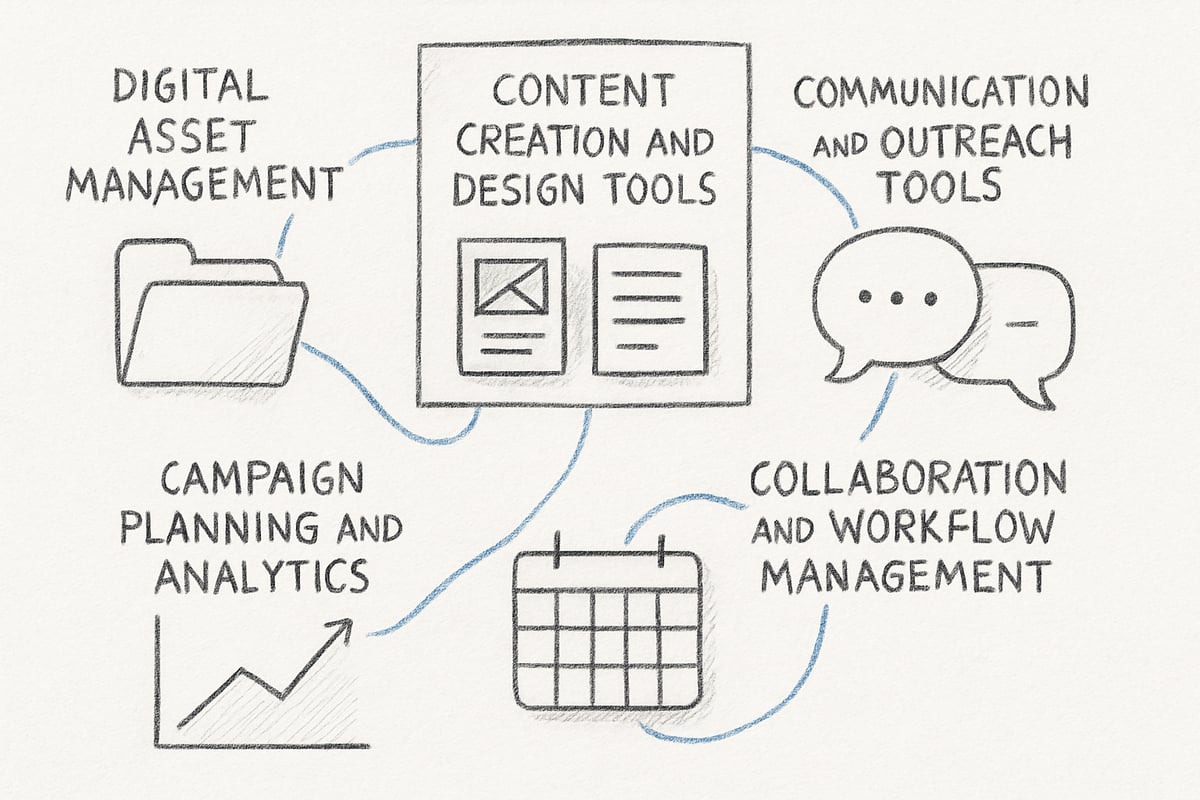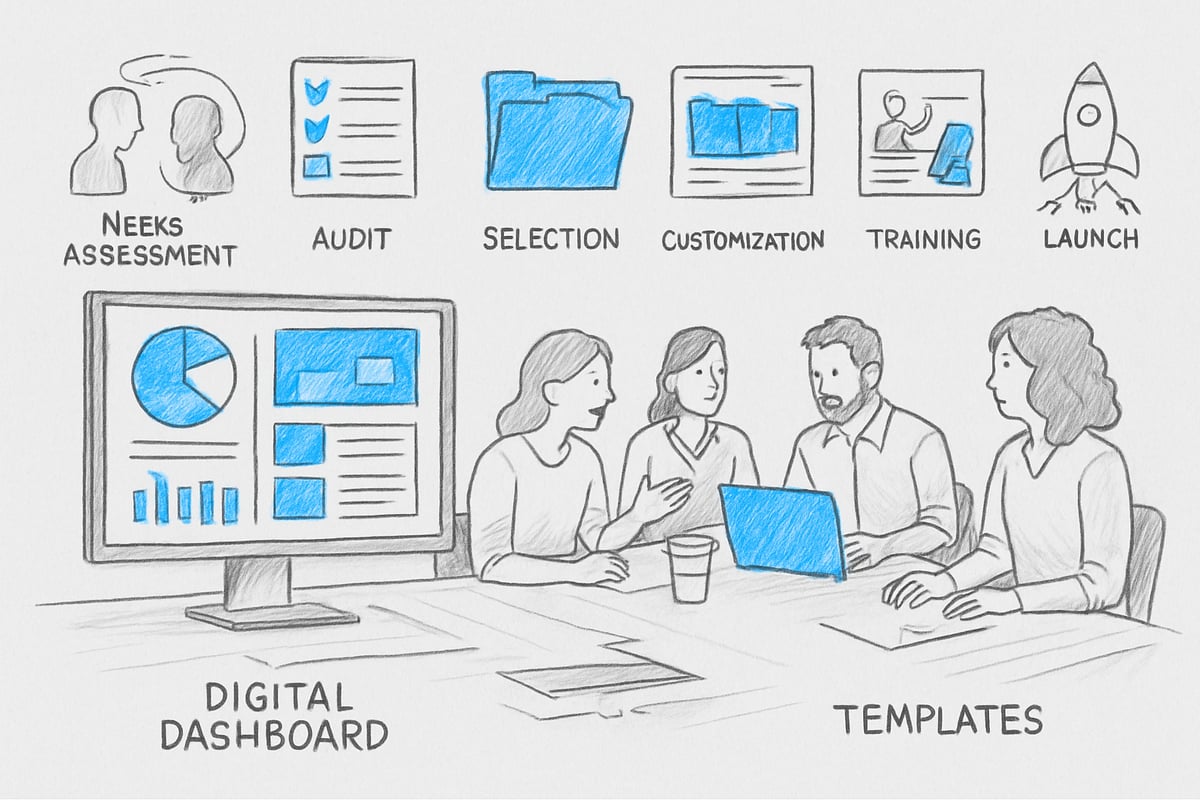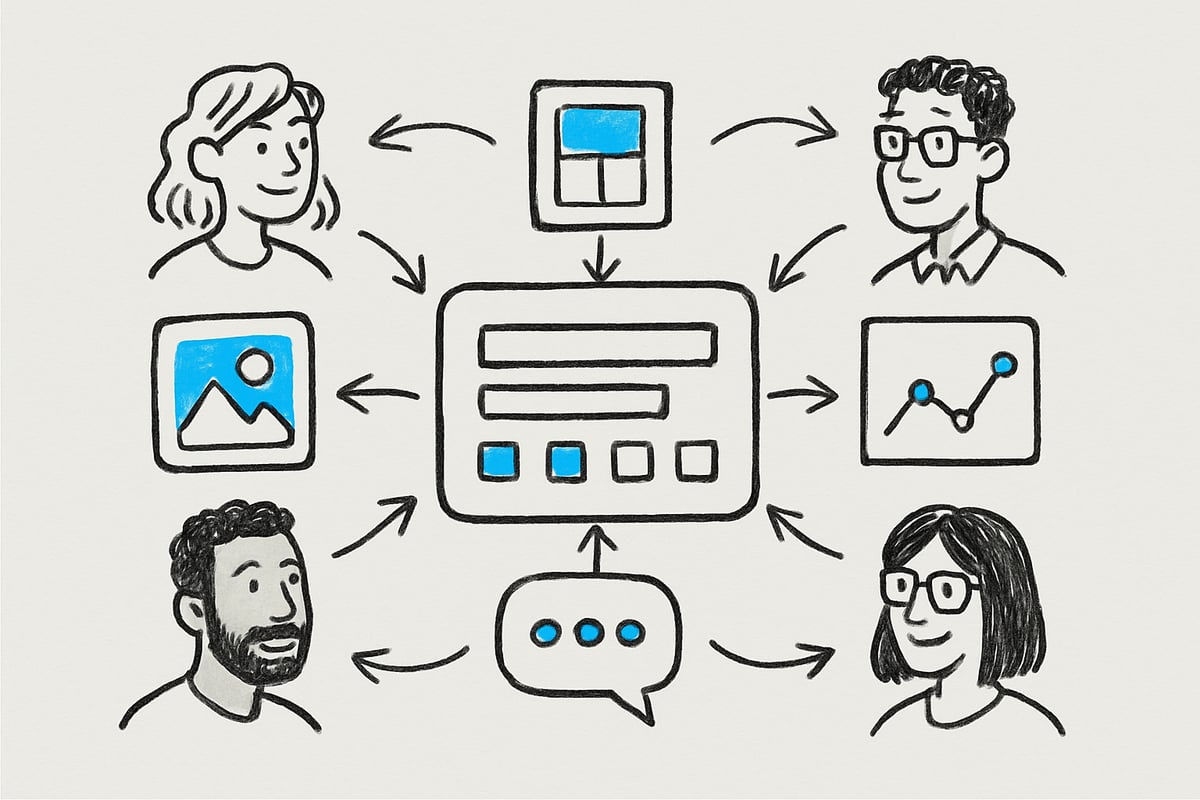In 2025, the marketing landscape is evolving at lightning speed, with new technologies and data-driven strategies shaping every campaign. To stay ahead, organizations must equip themselves with effective marketing toolkits that streamline processes and boost results. This essential guide breaks down what marketing toolkits are, reveals their core components, and provides step-by-step instructions to build a toolkit tailored for your needs. You will discover real-world examples, expert tips, and future trends to maximize your marketing impact. Ready to unlock measurable growth? Let us help you build or upgrade your marketing toolkit for the new era.
What is a Marketing Toolkit?
In today's fast-moving marketing world, organizations need more than a single solution—they need marketing toolkits that bring together the right mix of resources for every campaign. A marketing toolkit is a thoughtfully curated collection of tools, templates, and resources designed to streamline workflows and drive results. Unlike standalone tools, marketing toolkits offer structure, consistency, and scalability across all marketing efforts. For example, the National RTAP’s transit marketing toolkit serves as a sector-specific model, equipping teams with everything from photo libraries to campaign templates. This approach ensures every campaign is supported by cohesive, up-to-date resources, helping teams stay efficient and aligned. For more on how marketing toolkits are evolving, see The Marketer's Toolkit 2025, which details emerging strategies and trends.

Definition and Core Purpose
Marketing toolkits are more than just a set of digital tools—they are comprehensive collections that combine assets, templates, and guides to support every stage of a marketing campaign. Their core purpose is to simplify complex processes, reduce duplication, and maintain brand consistency. By using marketing toolkits, teams can quickly access approved resources, saving time and minimizing errors. This centralized approach streamlines planning, creation, and execution, making it easier to launch campaigns at scale. Notably, marketing toolkits differ from individual tools by offering a strategic framework that ties together all campaign elements for maximum impact.
Types of Marketing Toolkits
There are several types of marketing toolkits, each designed to meet different needs. Digital toolkits focus on online campaigns, including assets for social media, email, and web content, while traditional toolkits might include print ads and event materials. Industry-specific toolkits, such as those for public transit or health conferences, offer tailored resources for their unique audiences. Event-focused toolkits serve exhibitors, sponsors, or speakers, providing targeted promotional assets. Toolkits can also be internal, supporting staff, or external, guiding partners and stakeholders. For example, HIMSS creates segmented marketing toolkits to empower each participant group with the right materials.
Toolkit Benefits for 2025
The benefits of marketing toolkits are even more pronounced in 2025. Centralized resource management ensures everyone has access to the latest assets, while enhanced team collaboration speeds up project timelines. Marketing toolkits enable faster campaign execution and support data-driven decision-making by integrating with analytics platforms. They also empower organizations to implement seamless omnichannel marketing strategies, reaching audiences across print, digital, and in-person touchpoints. According to industry surveys, 70% of marketers report higher ROI when using integrated marketing toolkits, highlighting their importance for measurable growth.
Common Toolkit Misconceptions
Despite their advantages, marketing toolkits are sometimes misunderstood. One common misconception is that marketing toolkits are one-size-fits-all; in reality, every organization needs to tailor its toolkit to specific goals and audiences. Another pitfall is confusing a collection of tools with a true marketing toolkit, which should provide structure and strategic alignment. Over-relying on digital tools without a clear strategy can also undermine results. For instance, adopting a toolkit without proper training or alignment often leads to wasted resources and inconsistent campaigns. Understanding these misconceptions helps organizations get the most from their marketing toolkits.
Essential Components of a 2025 Marketing Toolkit
A successful marketing strategy in 2025 relies on having the right set of marketing toolkits. These toolkits are more than just collections of software; they bring together resources, templates, and systems that empower teams to work smarter, not harder. Let us break down the core components every organization needs to stay ahead in the rapidly changing marketing landscape.

Digital Asset Management
Effective digital asset management is foundational for modern marketing toolkits. Centralized libraries allow teams to store, organize, and share photos, illustrations, icons, and videos without confusion. For example, the National RTAP’s toolkit features a robust photo and illustration library, making it easy for teams to maintain brand consistency.
Version control and easy sharing reduce the risk of outdated assets being used in campaigns. A well-structured asset library supports scalability as marketing needs grow. For a deeper dive into what makes a toolkit effective, see 2025 Marketing Toolkit: 5 Essential Tools for Brand Success.
Content Creation and Design Tools
Content creation and design tools are vital elements of marketing toolkits. They offer pre-built templates for ads, flyers, posters, and presentations, streamlining the creative process. Customizable assets, like HIMSS promo slides and PowerPoint templates, help teams quickly adapt materials for different audiences.
Standardized templates ensure brand messaging remains consistent across campaigns. These tools are especially useful for organizations managing multiple campaigns simultaneously, as they save time and reduce the chance of errors. Templates can be updated as brand guidelines evolve.
Communication and Outreach Tools
Marketing toolkits in 2025 must include communication and outreach tools. Social media scheduling platforms, email marketing templates, and signature banners are crucial for timely, consistent messaging. For example, email signature templates used by HIMSS and RTAP help promote events organically through every team member’s correspondence.
These tools enable marketers to reach audiences across multiple channels without duplicating effort. Scheduling and automation features ensure that campaigns run smoothly, even with lean teams. Consistent outreach builds trust and maximizes engagement.
Campaign Planning and Analytics
Campaign planning and analytics tools are at the heart of data-driven marketing toolkits. These resources help teams map out campaigns, track progress, and measure results in real time. Integration with analytics dashboards enables marketers to optimize ongoing campaigns based on up-to-date performance data.
With access to detailed reporting, teams can make informed decisions and pivot strategies as needed. This component is essential for organizations aiming to prove ROI and refine their marketing efforts continuously. Data-driven planning leads to more successful outcomes.
Collaboration and Workflow Management
Collaboration and workflow management tools are indispensable in today’s marketing toolkits. Shared calendars, project management boards, and approval workflows help teams coordinate across departments and with external partners. For instance, RTAP’s marketing workbook is a practical tool for collaborative planning and resource sharing.
These tools break down silos, foster transparency, and speed up project delivery. Clear workflows ensure everyone understands their responsibilities and deadlines. When collaboration is seamless, campaigns launch faster and with fewer mistakes.
Step-by-Step: Building Your Marketing Toolkit for 2025
Building effective marketing toolkits for 2025 requires a structured approach. By following a clear set of steps, you can ensure your organization chooses and implements the right combination of tools, resources, and processes. Below, you will find a practical, actionable guide to assembling marketing toolkits that drive measurable results.

Step 1: Assess Organizational Needs
Start by defining the specific goals your marketing team aims to achieve in 2025. Consider what outcomes matter most, such as increasing brand awareness, driving event attendance, or boosting online engagement. Map out the marketing channels you plan to use, including social media, email, and print.
Identify the unique challenges your organization faces. For example, public transit agencies may prioritize passenger communication, while conference organizers focus on exhibitor and speaker engagement. In this step, clarify which campaign types and audiences matter most.
By aligning objectives and channels, you create a strong foundation for your marketing toolkits. This assessment ensures that your toolkit will be tailored, comprehensive, and ready to address real-world needs.
Step 2: Audit Existing Tools and Resources
Conduct a thorough inventory of your current marketing assets, platforms, and processes. List all tools in use, from content creation apps to analytics dashboards. Identify gaps, redundancies, and integration challenges that may hinder efficiency.
Look for outdated resources or underused platforms that could be replaced or consolidated. Use models like RTAP’s resource library to guide your audit, ensuring no asset is overlooked. Document each tool’s purpose, user access, and integration points.
A precise audit of your marketing toolkits enables you to build on strengths, address weaknesses, and avoid unnecessary duplication. This clarity sets the stage for smarter toolkit selection and deployment.
Step 3: Select Toolkit Components
With your audit complete, choose the essential components for your marketing toolkits. Prioritize tools that are scalable, user-friendly, and compatible with your existing infrastructure. Consider digital asset management, content creation, communication platforms, analytics, and workflow management.
Interoperability is key. Select solutions that integrate seamlessly, reducing friction between teams. For inspiration, review sector-specific examples and practical checklists like What Every Marketing Kit Should Include in 2025.
Careful selection ensures your marketing toolkits will support collaboration, streamline work, and deliver measurable ROI.
Step 4: Customize Templates and Assets
Adapt templates and assets to reflect your brand’s identity and campaign goals. Create sector- or campaign-specific graphics, banners, and documents. Use customizable templates for ads, flyers, presentations, and social posts to maintain consistency.
Marketing toolkits should offer flexibility. Allow teams to personalize messaging and visuals while preserving core branding. Example: Custom banners for events or tailored social media templates for different departments.
Well-designed assets inside your marketing toolkits accelerate campaign development and help maintain a unified presence across all channels.
Step 5: Train Teams and Set Guidelines
To maximize the impact of marketing toolkits, invest in comprehensive training. Host workshops or webinars to introduce new tools, templates, and best practices. Document clear usage policies and branding guidelines for all team members.
Encourage hands-on learning and feedback. Use resources like RTAP’s marketing webinars as models for ongoing education. Effective training ensures everyone understands how to leverage the toolkit’s features and avoids common mistakes.
Consistent training and guidelines empower teams to use marketing toolkits confidently, driving better results and minimizing errors.
Step 6: Launch, Monitor, and Iterate
Roll out your marketing toolkits in manageable phases. Start with a pilot group to gather initial feedback, then expand access organization-wide. Monitor usage, collect data on performance, and solicit user input for continuous improvement.
Regularly update assets, templates, and processes based on analytics and feedback. This iterative approach keeps your toolkit relevant and effective in a rapidly changing environment.
By actively monitoring and refining marketing toolkits, your organization stays agile, competitive, and ready to meet new challenges in 2025.
Integrating Your Toolkit for Maximum Impact
Integrating marketing toolkits is essential to unlock their full value in 2025. A well-integrated toolkit centralizes assets, aligns with strategy, and ensures consistency across every channel. This section explores how to weave marketing toolkits into the fabric of your organization for measurable results.

Centralizing Resources and Access
Centralizing resources is the foundation of effective marketing toolkits. Cloud-based platforms give teams universal access to photos, illustrations, and templates. This approach eliminates silos, making it easier to discover and use assets.
A centralized hub streamlines version control and reduces wasted time searching for files. For example, organizations using a shared photo or illustration library ensure that everyone works with up-to-date materials. This simple shift can dramatically improve efficiency.
Aligning with Marketing Strategy
Marketing toolkits must reinforce your core marketing strategy. Each toolkit component should map directly to a stage in your campaign workflow, from planning to execution and analysis. Integration is key: connect planning tools with templates, and ensure automation supports your goals.
For teams seeking efficiency, incorporating automation for marketing campaigns can drive seamless execution and allow marketers to focus on strategy. By building automation into your toolkit, you ensure that repetitive tasks do not slow progress.
Cross-Channel Consistency
Consistency across print, digital, and in-person channels is vital for brand recognition. Marketing toolkits help maintain this consistency by providing shared templates for ads, social posts, and emails.
When every team uses the same assets and messaging frameworks, branding remains unified. For example, event organizers supply participants with branded templates, ensuring a cohesive presence across platforms. This uniformity builds trust and amplifies your message.
Data and Analytics Integration
Modern marketing toolkits should connect campaign tools to analytics dashboards. Real-time reporting lets teams track performance across multiple channels for a holistic view. This integration supports data-driven decision-making and rapid optimization.
Workbooks and dashboards within marketing toolkits allow for easy recording and evaluation of campaign results. By centralizing analytics, you can spot trends, address gaps, and celebrate wins with precision.
Collaboration Across Teams
True integration means facilitating collaboration between marketing, sales, and partners. Shared calendars, project boards, and feedback loops are vital components of marketing toolkits. These features ensure everyone stays aligned and projects move forward smoothly.
For example, collaborative planning workbooks help teams assign tasks, set deadlines, and review progress together. This approach breaks down barriers and fosters a culture of shared success with marketing toolkits at the center.
Real-World Examples and Success Stories
Real-world adoption of marketing toolkits demonstrates their transformative impact across sectors. From public transit to global conferences and small businesses, these examples reveal how the right toolkit can drive engagement, efficiency, and measurable growth.
Public Transit Marketing (RTAP)
The National RTAP’s marketing toolkits have revolutionized how transit agencies connect with their communities. Agencies now use centralized photo libraries, professionally designed schedule templates, and unified branding assets to streamline outreach.
This approach has led to more consistent messaging and easier campaign launches. As a result, public perception has improved and ridership numbers have grown. The toolkit’s collaborative features enable teams to quickly adapt campaigns, keeping services relevant and accessible. For transit, marketing toolkits are now essential for building trust and driving participation.
Event Marketing (HIMSS)
HIMSS, a leading health conference, offers segmented marketing toolkits for exhibitors, speakers, and sponsors. These tailored toolkits include customizable promotional slides, social media templates, and branded banners, empowering participants to amplify their presence.
By standardizing materials, HIMSS ensures cohesive branding across all channels. The result? Increased booth traffic and higher session attendance. Participants benefit from ready-to-use assets, saving valuable time. For event organizers, marketing toolkits foster engagement and maximize event impact.
Small Business Toolkit Adoption
A local retailer adopted digital marketing toolkits to launch omnichannel campaigns. With templates for emails, flyers, and social media, plus integrated analytics, the business could coordinate efforts and monitor results in real time.
This streamlined workflow improved campaign efficiency and boosted ROI. The retailer also leveraged AI tools for marketing strategies to automate repetitive tasks, freeing up time for creative work. For small businesses, marketing toolkits offer a scalable way to compete and grow.
Lessons Learned and Best Practices
Successful marketing toolkits require ongoing updates and responsive support. Teams that gather user feedback and refine resources see better results. Avoiding over-complication and providing clear training are critical for adoption.
Regularly updating templates and integrating new tools keeps campaigns fresh. Collaboration and feedback loops ensure the toolkit evolves with organizational needs. Ultimately, marketing toolkits are most effective when tailored, dynamic, and user-focused.
Future Trends in Marketing Toolkits for 2025 and Beyond
The landscape of marketing toolkits is evolving rapidly, and staying ahead means embracing emerging trends. In 2025 and beyond, organizations must adapt their toolkits to harness cutting-edge technologies, personalization, new channels, compliance, and continuous skill development. Let’s explore what the future holds for marketing toolkits.
AI and Automation
Artificial intelligence is reshaping how marketing toolkits function. From automated content creation to predictive analytics, AI tools are streamlining campaign management. Automated social media scheduling, content recommendations, and real-time reporting are now standard features.
For example, AI-driven platforms can generate personalized email content or suggest optimal posting times. This not only saves time but also boosts engagement. To dive deeper into how AI is transforming marketing toolkits, explore Marketing with artificial intelligence.
Personalization and Customization
In 2025, marketing toolkits are enabling hyper-personalized campaigns. Dynamic templates allow marketers to segment audiences and tailor messaging for each group. Event toolkits, for instance, now include role-specific assets for exhibitors, speakers, and sponsors.
Personalization is no longer optional. With consumers expecting relevant experiences, marketing toolkits that support advanced segmentation and customization are critical. For more on core elements of effective toolkits, see 7 Key Components of a Marketing Plan for 2025.
Integration with Emerging Channels
The rise of video, interactive, and AR/VR content is reshaping the components of marketing toolkits. Modern toolkits must support these formats, ensuring marketers can create and distribute immersive experiences across new digital platforms.
Inclusion of video templates, interactive content, and tools for AR/VR assets is becoming standard. Adapting to emerging channels ensures that marketing toolkits remain relevant and effective in an ever-changing digital environment.
Data Privacy and Compliance
With growing regulations like GDPR and CCPA, data privacy is a top priority for marketing toolkits. Built-in compliance checks help organizations avoid costly mistakes. Secure asset management and centralized control over branding and messaging are now essential features.
Marketers rely on toolkits that simplify compliance, provide audit trails, and ensure that sensitive data is handled properly. This focus on privacy protects both organizations and their audiences.
Continuous Learning and Support
The future of marketing toolkits includes robust training and support. Ongoing webinars, resource updates, and community-driven enhancements ensure teams stay current with best practices. Regular feedback loops help refine toolkit resources for evolving needs.
Organizations investing in continuous learning see better adoption and improved results from their marketing toolkits. The emphasis on support and education is key to long-term success.
